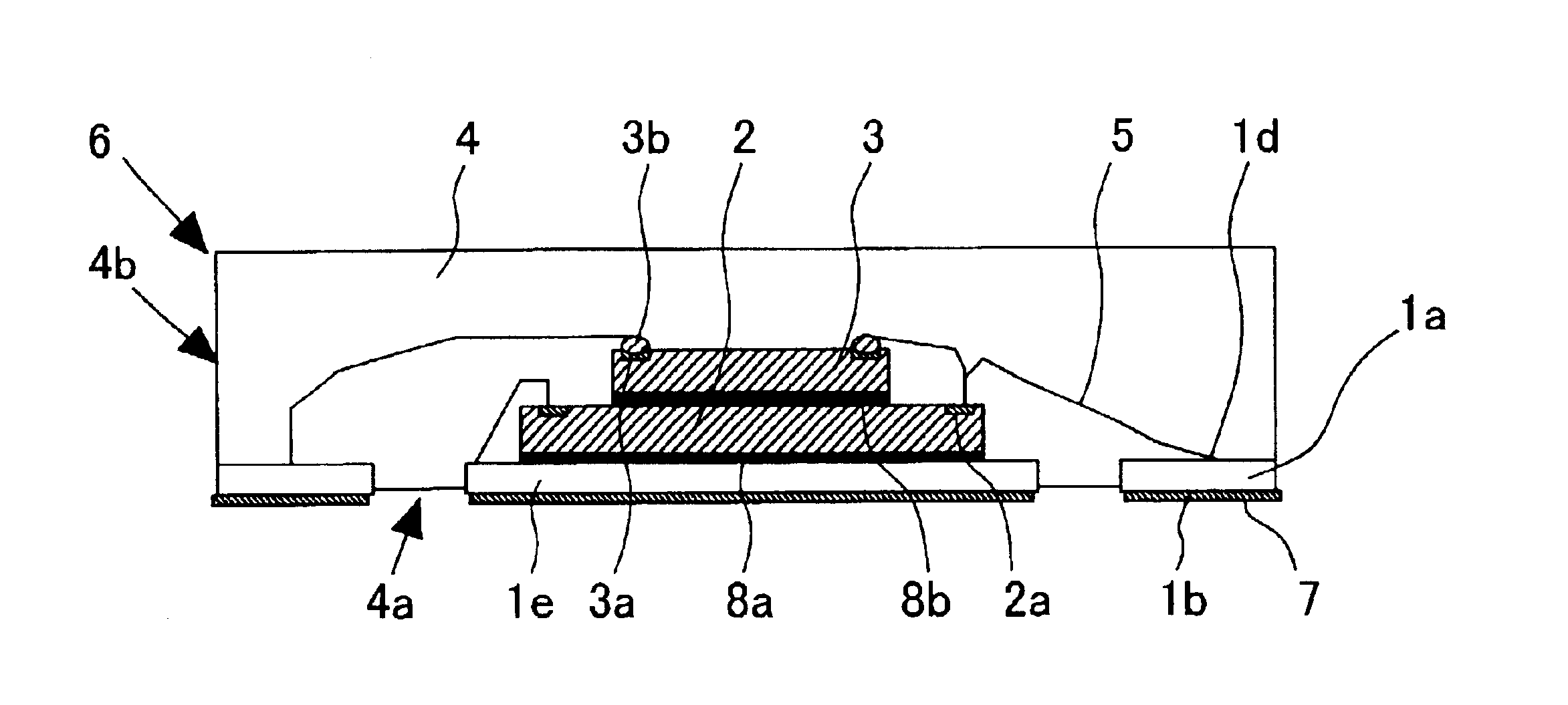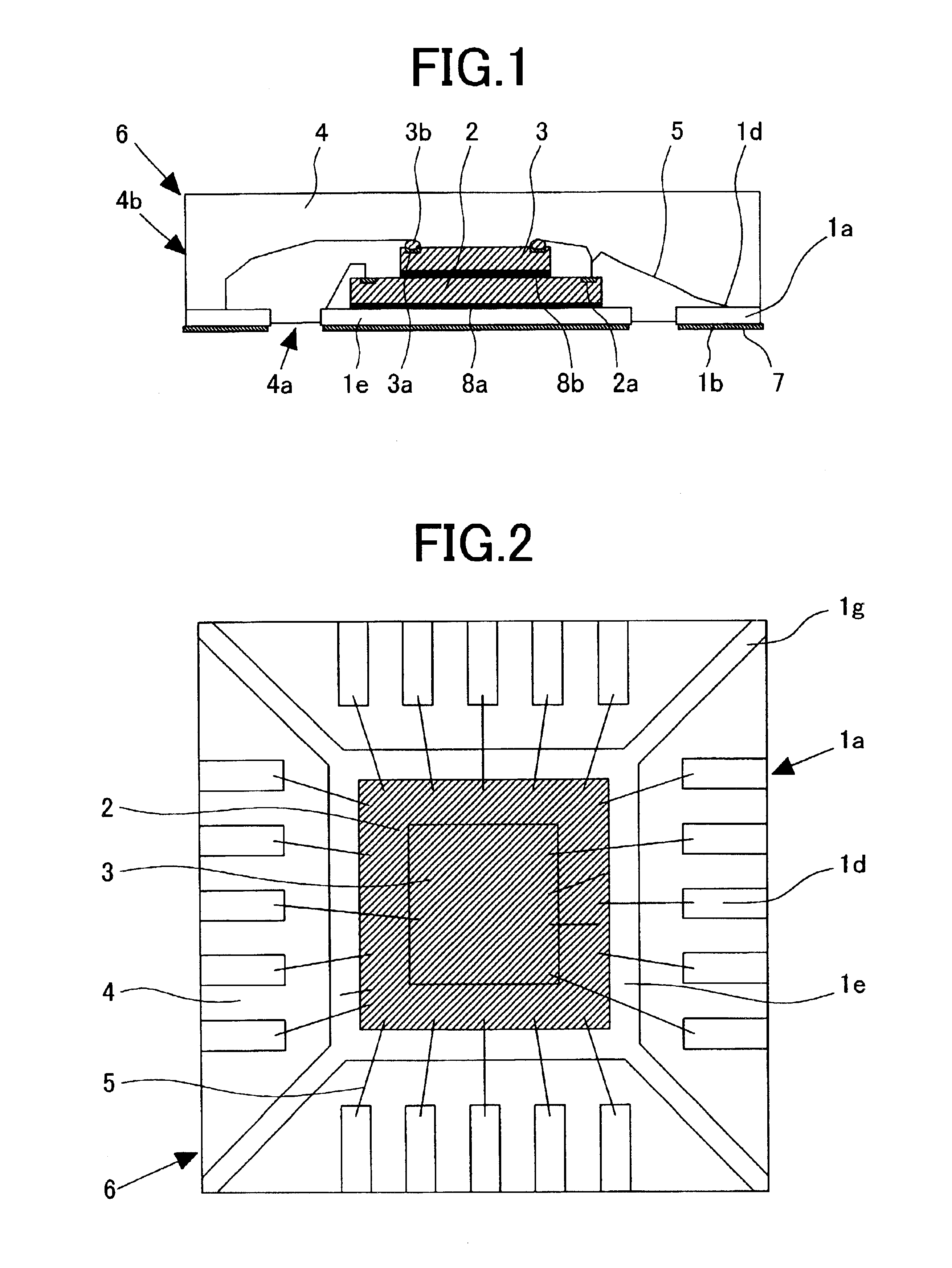Semiconductor device and its manufacturing method
- Summary
- Abstract
- Description
- Claims
- Application Information
AI Technical Summary
Benefits of technology
Problems solved by technology
Method used
Image
Examples
first embodiment
(First Embodiment)
Description of the first embodiment will be given in conjunction with FIGS. 1 to 13.
A semiconductor device shown in FIGS. 1 to 3 is a semiconductor package of a resin-sealed type and a surface-mounting type employing a lead frame. In the description of the first embodiment, the tab-exposed type semiconductor device 6 is taken as an example of this semiconductor device.
As shown in FIG. 1, in the semiconductor device 6, a first semiconductor chip 2 is adhered and supported on a second surface opposite to a first surface to be a circuit forming surface, via a conductive die bond material 8a such as silver paste or adhering film on a tab 1e (chip mounting portion). A second surface of a second semiconductor chip 3 is stacked and mounted on the first surface of the first semiconductor chip via an insulative die bond material 8b such as silicone rubber and insulative sheet, etc. Also, a plurality of electrode pads 2a and 3a of the respective semiconductor chips and a plu...
second embodiment
(Second Embodiment)
Description of the second embodiment will be given in conjunction with FIGS. 14 to 26.
The semiconductor device shown in FIGS. 14 to 16 is a semiconductor package of a resin-sealed type and a surface-mounting type employing a lead frame. In the description of a second embodiment, the semiconductor device 6 of a tab-embedded type is taken as an example of this semiconductor device.
As shown in FIG. 14, in the semiconductor device 6, a second surface of a first semiconductor chip 2, which is opposite to a first surface to be its circuit forming surface, is adhered and supported on a tab 1e (chip mounting portion) via a conductive die bond material 8a such as silver paste or adhering film. A second semiconductor chip 3 is stacked and mounted on the first surface via an insulative die bond material 8b such as silicone rubber or insulative sheet, etc. Also, a plurality of electrode pads 2a and 3a of each semiconductor chip and a plurality of leads 1a are connected by con...
third embodiment
(Third Embodiment)
FIG. 27 is a cross-sectional view showing an example of a structure of a semiconductor device according to a third embodiment of the present invention, and
FIG. 28 is a plan view showing the structure of the semiconductor device 6 shown in FIG. 27.
The semiconductor device shown in FIGS. 27 and 28 is a semiconductor package of a resin-sealed type and a surface-mounting type employing a lead frame. In the description of the third embodiment, the semiconductor device 6 is taken as an example of this semiconductor device.
As shown in FIG. 27, in the semiconductor device 6, a first surface of the first semiconductor chip 2, which is a circuit forming surface, is supported on one surface of a frame-shaped tab 1e (chip mounting portion) through, for example, silicone rubber or insulative sheet or the like. A second surface of the second semiconductor chip 3, which is opposite to a first surface thereof, is stacked and mounted on the first surface of the first semiconductor ...
PUM
 Login to View More
Login to View More Abstract
Description
Claims
Application Information
 Login to View More
Login to View More - R&D
- Intellectual Property
- Life Sciences
- Materials
- Tech Scout
- Unparalleled Data Quality
- Higher Quality Content
- 60% Fewer Hallucinations
Browse by: Latest US Patents, China's latest patents, Technical Efficacy Thesaurus, Application Domain, Technology Topic, Popular Technical Reports.
© 2025 PatSnap. All rights reserved.Legal|Privacy policy|Modern Slavery Act Transparency Statement|Sitemap|About US| Contact US: help@patsnap.com



